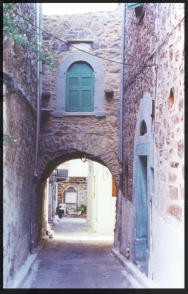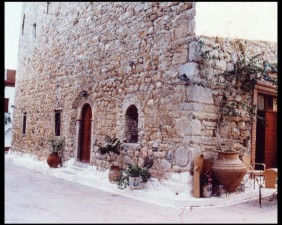 |
 |
          |
CHRYSANTHI
TRADITIONAL APARTMENTS
OLYMPI CHIOS
LOCATION INFORMATION
|
|
|
The Olympi village, located in the southwest part of Chios, belongs to the Municipality of Mastichohoria, covering an area of 13 million square meters. It is 32 kilometers from the town center and 8 from the Mesta port. It is bounded by the Pyrgi village, in the east, at an 8-km distance, the Mesta village, in the west, at a 3-km distance and the Elata and Potamoi villages, in the north, at an 8-km distance. Aggelia, Chondri Anmmos, Kato Fana and Aghia Dynami, the well-known beaches of the area form Olympi's south border.
|

|

|
The village was called Olympi after mount Olympos on which it was built and is bounded by Sarakinos, Palamides and Mallidies Mountains.
Olympi was built in the 13th century during the Era of Palaeologus Dynasty [Constantine, the last Byzantine emperor who was killed in the final defense of Constantinople against the Ottoman Turks and his brothers Theodore and Thomas.] It is one of the remaining medieval villages that survived the 1881 earthquake.
|
|
|
|
In the beginning, there were two villages:
1.)Ano
Olympi and
2.)Vrakana, and 6 settlements: i.)Gonies,
ii.)Thias,
iii.)Alona,
iv.)Kastraki,
v.)Diskoria and
vi.)Vrekos, scattered around the region, at the time.
|

|
|
|
|

|
But they were united to form one big village,
Olympi, in order to keep safe from pirates' raids. That village was protected by a fortress with four pyrgopoula (battlements which, unfortunately, are not preserved nowadays.)
The residents would get into and out of the village through a Gate preserved till present time (Kato Porta.) That gate would close after dark and during pirates' raids.
|
|
|
At the center of the village, stands Pyrgos (the Tower), a stately and impressive structure of about 20 meters height and an area of 245 square units with thick walls 1.75 meters each.
Pyrgos was a watchtower being in direct contact with other observation towers that lay off shore and guards or lookouts were stationed to keep watch for enemies. Whenever pirates were spotted, fires were set and, thus, inhabitants were notified of the danger and got into the walls of the village to protect themselves. Pyrgos not only constituted an observation place but the last point of defence of the village, too. If, somehow, enemies broke the external walls defence, the inhabitants would get into Pyrgos.
|
 |
 |
The Churches of Olympi
1. Aghia Theodossia: the smallest and most long-standing church in the village. It was built in the 12th century.
2. Aghia Paraskevi: lying at the center of the village. It was built in the middle of 13th century. Its invaluable woodcut temple carved in the 10th or 11th century is preserved till present time.
3. Aghios Georghios: built in 1866. It lies in the northern part of Aghios Georghios village.
4. Aghios Nicolaos: built in 1850. It lies in the northern part of Aghios Nicolaos village.
5. Taxiarchis Gavriel: built in 1708. It lies next to Aghia Paraskevi.
6. Stavros: built in 1857 at the entrance of the village.
|
|
|
|
Kato Fana

The village was called Kato Fana after the Fanaios Apollo temple. It lies in the southern-east of the
Olympi village at a distance of 5 km. In the past, the water reached to the temple. That was the place the Ionians built a temple at to honour Fanaios Apollo. An isosceles triangle is formed by Apollo's temple, Dilos temple and Poseidon's temple in Sounio.
The temple was called Fanaios [Greek word, φαίνομαι (fainomai) = appear, show, stand out a mile etc.] because the temple of Dilos stands out a mile if there are fair skies. The Statue of Fanaios Apollo, made of silver and gold, was laid on a gold-coated pillar. It has not been found, so far.
|
|
|
 |